Yamaha MT-09 SP test: the one we Sought !
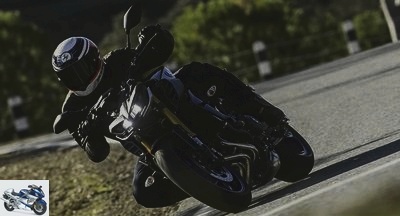
The Yamaha MT-09, one of the stars of the French motorcycle market, never ceases to enchant bikers eager for emotions. As playful as she is luscious, one could blame her for a suspension that did not quite live up to her ambitions. In this SP version, the sparkling 2018 roadster receives a new fork and an Ohlins shock absorber. So happy ? First try.
MT-09 SP test page 3: Technical point
Engine
Yamaha Europe announces that it has sold 37,810 MT-09 since it entered production at the end of 2013. In 2017 in France, the roadster arrived, Z900, CB500 and … MT-09 Tracer in volume. The time had come (again) to boost sales of MT-09, whose distributor plans to sell 30% of this new SP version this year..
As mentioned in the previous spages of this new MNC test, the MT-09 SP 2018 differs from the standard 2017 version mainly by its suspensions. If the in-line three-cylinder, preconfigured Euro4 as soon as it was released, had undergone some changes in 2017 (injection, structure of the exhaust plenum chamber in three parts), it has not received any new modifications this year..
This CP3 engine has the same dimensions (78 x 59.1 mm), the same compression ratio (11.5: 1) and above all identical power and torque values: 115 hp and 87.5 Nm, obtained at the same speeds (respectively at 10,000 rpm and 8,500 rpm).
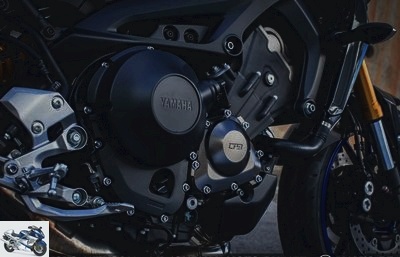
Injection is always controlled by a ride-by-wire electronic accelerator, subject to three maps that can be configured while driving. Said injection is carried out by means of injectors with 12 holes mounted directly on the cylinder head, an advantageous solution in terms of space saving and spraying efficiency. Despite progress compared to the first model and an update made in 2015, this injection still lacks transparency and progressivity…
Small mechanical peculiarity of the MT-09: it has intake ducts of different lengths (102.88 mm, 82.8 mm and 122.8 mm) in order to improve engine filling at medium and high speeds. This configuration also serves the cause of the sound, "grumpy" at will when the air-gasoline mixture is sucked into each of the three cylinders..
The cylinders are also offset by 5 mm from the center of the crankshaft, so as to be able to better position the connecting rod and reduce the stresses on the piston. In this way, internal friction is reduced in favor of efficiency, consumption (5.6 l / 100 km observed on the on-board computer during our test) and mechanical longevity. The engine timing is fixed at 120 °, or ignition intervals at 0 °, 240 ° and 480 °. The pistons are therefore never in neutral at the same time.
Identical to that adopted by Triumph on its "Tripeul", this setting combines the advantages: cyclic regularity, good operating range and smoothness. To perfect its qualities, Yamaha has installed a balancing pendulum to filter parasitic vibrations. In use, very slight tremors are felt on the fingers in the levers and under the feet, especially noticeable because the footrests are not covered with rubber.
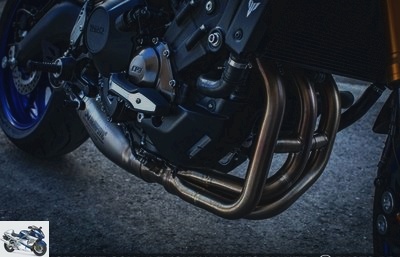
The exhaust system of this light engine (10 kg less than the 4-leg of the FZ8 as a reminder!) Is based on a 3-in-1 manifold connected to a short side silencer (Akrapovic above available in the accessories department ). The end is covered with a metal cover to give the impression of a beveled exit. This low and close arrangement of the engine is excellent for mass centralization.
Since 2017, the clutch adopts an anti-slip device which releases the pressure of the discs slightly and briefly to prevent lock-ups during downshifting. This system also lowers the force to be provided to the left lever, by "20%" according to Yamaha..
Finally, the service interval is set at 1000 km for the traditional "break-in oil change", then "every 10,000 km", reveals Yamaha Motor France about this motorcycle with final transmission by chain.
Cycle part
The die-cast perimeter aluminum frame has not moved since the first version. This chassis consists of two parts bolted together at the level of the steering column and the axis of the swinging arm. The whole, which gives off a pleasant feeling of robustness, is very correctly assembled..
The main change last year was the 29mm shortening of the rear buckle. Paradoxically, the passenger seat was lengthened by 13 mm: the reason is "better use of the available space", Yamaha explained to us at the time..
Too bad that Iwata’s coat of arms did not take the opportunity to graft it with a worthy chest: a yellow vest and a disc lock enter the space under the saddle, nothing more. The rider’s seat had grown by 5 mm, the position being slightly more tilted forward..
The frame geometry is still unchanged in 2018, with a short wheelbase of 1440mm, 25 ° caster angle and 103mm caster. So many quite "sporty" values which are at the origin of the agile and playful behavior of the motorcycle..
The Kayaba fork, which retains a high travel (137 mm), has seriously moderated the front end of the MT-09 SP despite the lack of steering damper: exit the sometimes sharp reactions. We remember that the trigger of the previous one was adjusted on the top of the right tube and the compression on the left tube..
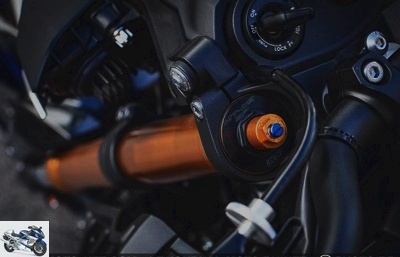
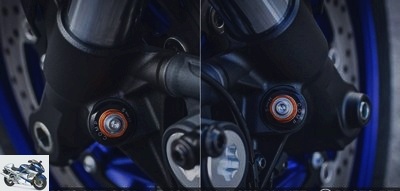
The new one offers the same spring preload and hydraulic rebound settings on its two tubes. On the two fork legs, near the calipers, there is now a screw and a nut allowing to adjust the slow and fast compressions. This refinement makes it possible to better manage the sag of the fork under braking or on small unevenness in the road, which could make owners of previous vintages shudder..
To justify its Premium positioning, the MT-09 SP entrusts the rear suspension to an Ohlins mono-shock absorber, a fully adjustable RSA model installed horizontally, an interesting position because the spring and the rods are in this way less exposed to projections..
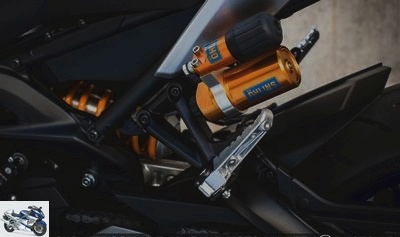
Worthy of the best hypersportives, this handset provides a firmer reaction, but also more contained than the previous one, in perfect harmony with the fork. The cylinder fixed nearby – too much ?! – of the left passenger footrest has a compression adjustment, while a knob placed at its side allows the spring tension to be adjusted. At the foot of the shock absorber rod, a notched rotary knob offers the possibility of adjusting the rebound.
Everything is easily accessible in order to quickly adapt the suspension to the state of the road, as well as to the load (duo, luggage) or the type of driving and, why not, to the track on which the MT-09 SP should look good despite the footrests placed a little low (adjustable plates and cut in the mass are in the accessories catalog).
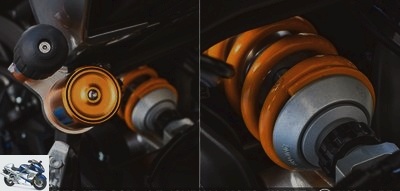
Under braking, the MT-09 line is adorned at the front with the same 298 mm floating discs bitten by very efficient radial 4-piston calipers and, at the rear, a 245 mm disc with a single-piston caliper. . This device is not coupled, but receives the support of a mandatory ABS, but neither adjustable nor deactivatable.
The ten spoke aluminum rims receive very efficient Bridgestone S20 as standard equipment. Finally, note the conservation of a deported license plate support, in the form of an aluminum arm fixed to the asymmetric swingarm, also in aluminum. Finally, the full weight is only 193 kg.
Electronics and piloting aids
The MT-09 benefit from three different injection maps, selectable from the right stalk. These three modes offer a more or less lively response to acceleration depending on whether the mapping "A" (the sportiest), "standard" or "B" (useful in the wet) is selected. The passage from one to the other can be done while driving, gas cut.
This device intervenes only on the way in which the power is delivered, and not on its value: the 115 ch are present whatever the engaged mode. Heavily criticized for the lack of progressiveness and the jerks generated by the injection (especially in mode A), Yamaha has refined its operation in 2017 … but it is not yet completely satisfactory. On a daily basis, mode "B" is the most pleasant, because the softest.
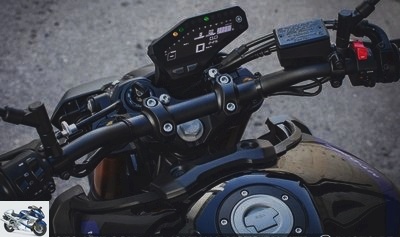
From 2016, the MT-09 was fitted as standard with the "TCS" traction control system, a device released by Yamaha on the Super Tenere in 2010, then on the 2012 R1 and on the FJR1300 the following year. Disconnectable when stationary from the dashboard, this traction control is continuously informed about the speed of rotation of the wheels by the toothed crowns of the ABS.
As soon as it detects a difference between the front and the rear, the ECU (electronic brain of the system) crosses this information with that collected by the electronic accelerator (gear engaged, engine speed, degree of throttle opening, in particular) and adapts its action accordingly.
In the event of a brief loss of traction, it orders, for example, a slight closing of the throttle flaps via the ride-by-wire in order to regulate the power and restore grip to the rear wheel. If the slip is more marked, the TCS then intervenes on the ignition advance, intervention more sensitive to the handlebars.
Finally, if this is not enough or the situation turns to the extreme, the device opts squarely for an ignition cut-off, in this case causing a sudden activation and jerky operation. In all cases, its entry into service is signaled by the flashing of an orange "TCS" light on the bottom of the fully digital dashboard, repositioned on the headlight for better readability..
Fairly simple in its operation, the Yamaha TCS is not informed by gyroscopes capable of indicating the inclination of the motorcycle. However, its well-calibrated intervention threshold and its good reactivity make it sufficiently efficient and pleasant in the vast majority of cases. The only complaints: adjusting its sensitivity (on two levels) or deactivating it is impossible while driving … And it does not tolerate wheelies triggered by the clutch, even on its least interventionist threshold (1), unlike that of the !
Finally, since 2017 a standard shifter facilitates the upshift. This device causes a micro ignition cut-off when the selector is lifted – and not pushed back – which allows upshifting without disengaging or shutting off the throttle. In use, this shifter is practical and its correct functioning, without however achieving the reactivity and flexibility of that of the from which it derives, nor the transparency of certain equipment of the competition..
Related articles
-
2017 Yamaha YZF-R6 test: no, the Supersport is not dead Yamaha is the only major motorcycle manufacturer to keep its 600 cc sports car in its catalog in…
-
Tmax 2017 SX and DX test: Yamaha gives (sells) its maximum ! Yamaha is launching its new Tmax 530 2017, available in three models: the standard, the…
-
All Tests – MT-09 Tracer Test: Yamaha traces to success! – Technical update MT-09 Tracer 2015
Test MT-09 Tracer: Yamaha traces to success ! In 1991, Yamaha set foot in the dish with TDM, a multi-genre and multitasking motorcycle. 23 years later,…
-
Roadster – Test Yamaha MT-09 2017: mult (r) iples pleasures! – Page 3 – Technical point MT-09 2017
2017 Yamaha MT-09 review: mult (r) iples pleasures ! Having become a bestseller in just four years, the Yamaha MT-09 is full of positive developments for…
-
2017 Yamaha MT-09 review: mult (r) iples pleasures ! Having become a bestseller in just four years, the Yamaha MT-09 is full of positive developments for…
-
Roadster – Yamaha XSR 900 test: the MT-09 puts 3-legs in the retro – A very expressive roadster
Yamaha XSR 900 test: the MT-09 puts 3-legs in the retro After the XSR700 imagined in collaboration with Japanese designer Shinya Kimura on the basis of…
-
Yamaha Niken test: trying the three-wheeled motorcycle is taming it ! For more than ten years, Yamaha engineers have been racking their brains to offer a…
-
Yamaha MT-09 SP test: the one we Sought ! The Yamaha MT-09, one of the stars of the French motorcycle market, never ceases to enchant motorcyclists eager…
-
Custom – BMW K1600B test: Power Bagger! – Page 3 – Technical point MNC K1600B
BMW K1600B test: Power Bagger ! The last BMW custom motorcycle, the R1200C discontinued in 2004, did not leave lasting memories … It is different for…
-
Roadster – Yamaha XSR 900 test: the MT-09 puts 3-legs in the retro – Retro … but not too much!
Yamaha XSR 900 test: the MT-09 puts 3-legs in the retro After the XSR700 imagined in collaboration with Japanese designer Shinya Kimura on the basis of…